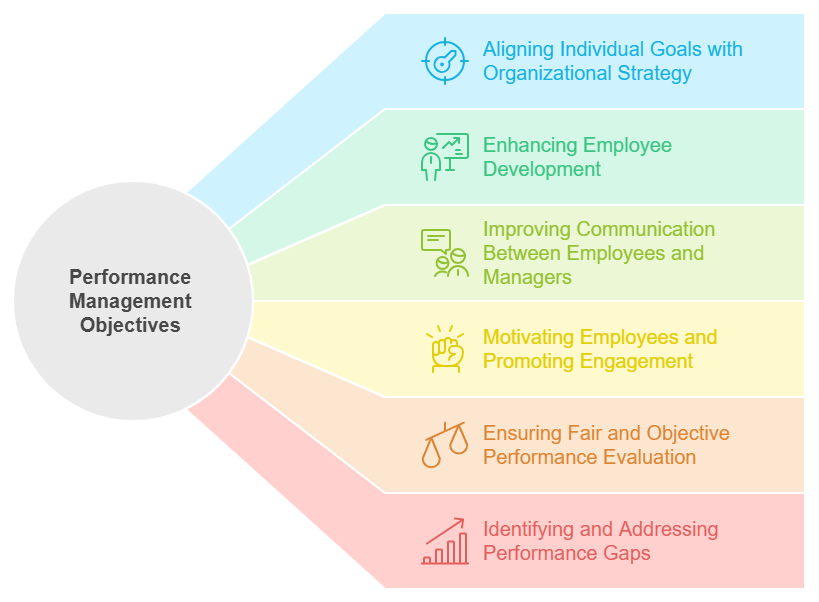When it comes to optimizing employee performance and achieving organizational goals, two terms often come up: Performance Management vs Performance Appraisal. While these concepts are closely related, they serve distinct purposes in employee development and organizational growth. This detailed blog will explore the nuances of both, their objectives, processes, advantages, and disadvantages, and highlight the key differences to help you understand how both impact employee performance and business outcomes.
What is Performance Management?
Performance Management is an ongoing process of setting clear expectations, monitoring progress, providing feedback, and fostering employee development. It involves aligning individual goals with organizational objectives, ensuring employees understand their roles, and guiding them toward achieving high performance. Performance management is a comprehensive approach that spans an entire year (or longer) and often includes regular check-ins, coaching, and performance reviews.
In contrast to performance appraisal, which typically focuses on periodic reviews, performance management is a continuous cycle that encourages improvement and growth throughout the year.
Key Elements of Performance Management
- Goal Setting: Establishing clear, measurable objectives for employees.
- Continuous Feedback: Providing ongoing feedback to help employees stay on track.
- Employee Development: Focusing on skill growth and career development.
- Performance Monitoring: Tracking performance regularly to assess progress.
- Recognition and Rewards: Acknowledging achievements and motivating high performers.
Objectives of Performance Management
Performance management is a comprehensive and ongoing process aimed at aligning individual performance with the strategic goals of an organization. Its primary purpose is not only to assess performance but also to enhance productivity, foster employee development, and improve overall organizational outcomes. Let’s understand the key objectives, exploring how each element contributes to a better workforce and a more effective business strategy.

1. Aligning Individual Goals with Organizational Strategy
One of the most fundamental objectives is ensuring that individual goals are in alignment with the company’s strategic objectives. When employees understand how their daily tasks and long-term goals contribute to the broader vision of the company, it creates a sense of purpose and direction. This alignment helps employees feel like their work matters and motivates them to strive for higher performance.
For instance, in a tech company, if the company’s goal is to develop new software products, individual employees’ objectives might revolve around improving coding efficiency, meeting product development milestones, and increasing customer satisfaction. Performance management ensures that these individual goals are clearly defined and consistently assessed to ensure the employee is moving toward the organization’s broader targets.
2. Enhancing Employee Development
Performance management is central to identifying development needs and creating opportunities for continuous learning. By monitoring and assessing employee performance, managers can pinpoint areas where an employee may need further development or training. This is not limited to technical skills but also includes soft skills like communication, leadership, and teamwork.
For example, if a sales manager consistently fails to meet their targets due to poor client engagement, performance management could identify this as a training need. Through this process, employees can be given the tools and resources they need to improve, leading to better performance over time.
The key here is personalized development which will surely include soft skills. A well-managed performance process focuses on each employee’s unique strengths and weaknesses, tailoring development plans that will help them grow in the most effective way possible.
3. Improving Communication Between Employees and Managers
Effective communication is essential to any successful organization, and performance management plays a significant role in fostering a continuous dialogue between managers and employees. Through regular feedback sessions, goal-setting meetings, and performance reviews, employees have the opportunity to discuss their challenges, career aspirations, and any concerns they might have.
This open exchange of information leads to stronger relationships and better understanding between employees and their managers. Employees gain insights into how their performance is perceived, and managers can provide guidance on what the employee needs to do to improve or meet their targets. In turn, this can also lead to authenticity, engagement, and morale.
For example, a quarterly one-on-one meeting might uncover that an employee is feeling overwhelmed with their workload, prompting their manager to reassess their responsibilities or provide additional resources. This communication ensures that issues are addressed in real-time, preventing them from escalating.
4. Motivating Employees and Promoting Engagement

Motivation is a key driver of productivity, and performance management can significantly boost employee engagement. Employees are more likely to feel motivated when they receive recognition for their achievements and constructive feedback on areas for improvement. By setting clear expectations and providing regular feedback, employees can track their progress and feel a sense of accomplishment as they meet goals.
Additionally, performance management encourages positive reinforcement through rewards such as bonuses, promotions, or career advancement opportunities. Acknowledging an employee’s hard work and contribution motivates them to maintain high standards, creating a more productive and engaged workforce.
For instance, a retail company might offer performance-based bonuses to employees who exceed sales targets. This incentive not only rewards high performers but also motivates others to work harder to achieve similar success.
5. Ensuring Fair and Objective Performance Evaluation
Performance management systems are designed to provide fair and unbiased evaluations. By using a structured framework to assess performance, organizations can ensure that all employees are judged according to the same criteria, reducing the potential for favoritism or discrimination. Regular reviews, combined with performance metrics, allow managers to objectively evaluate employee contributions, leading to more transparent decision-making processes.
For example, a software development company may use specific performance indicators such as code quality, bug fix rate, and project delivery time to evaluate employees, ensuring that each person is assessed fairly based on measurable achievements rather than subjective opinions.
Moreover, using many sources of feedback (such as peer reviews, self-assessments, and manager evaluations) helps to gain a more holistic and unbiased view of an employee’s performance. This approach improves trust in the performance evaluation process and ensures that employees feel valued and recognized for their contributions.
6. Identifying and Addressing Performance Gaps
One of the core functions of performance management is to identify and address performance gaps before they become bigger problems. By regularly monitoring an employee’s progress against their goals, managers can spot areas where performance is falling short. When these gaps are identified early, corrective actions can be taken to address the issue—whether that’s through additional training, changes in job responsibilities, or more frequent feedback and support.
For example, if an employee is struggling to meet deadlines, this review process allows their manager to identify this issue early on and work with them to develop strategies to improve time management. This proactive approach can help prevent performance issues from affecting productivity or the employee’s career trajectory.
How to Conduct Performance Management

A successful performance management process includes the following steps:
- Define clear expectations and goals: Set SMART (Specific, Measurable, Achievable, Relevant, Time-bound) goals.
- Monitor progress regularly: Track performance through periodic check-ins or one-on-one meetings.
- Provide feedback: Offer constructive feedback to guide employees toward achieving their goals.
- Encourage employee development: Identify areas for growth and provide learning opportunities.
- Assess performance: At the end of the review period, assess the overall performance and discuss achievements.
- Reward and Recognition: Offer incentives, rewards, or promotions to employees who meet or exceed expectations.
Advantages and Disadvantages of Performance Management
Advantages:
- Continuous development: Performance management fosters a culture of continuous improvement, where employees are encouraged to grow regularly.
- Increased employee engagement: Frequent interactions and feedback keep employees motivated and connected to organizational goals.
- Better alignment: It ensures that employees’ individual goals are aligned with the company’s broader objectives, driving business success.
- Improved productivity: Ongoing monitoring helps identify performance gaps early, allowing managers to address issues before they become bigger problems.
Disadvantages:
- Time-consuming: Regular check-ins, feedback sessions, and performance monitoring require substantial time and effort from managers.
- Potential for bias: Without a well-structured process, performance management can become subjective and biased.
- Overemphasis on metrics: Focusing too much on performance metrics might overlook other important aspects like creativity or teamwork.
What is Performance Appraisal?
Performance Appraisal is a formal yet classical evaluation of an employee’s job performance. It assesses how well an employee has performed their duties over a set period, usually through a rating system or qualitative feedback. They often result in decisions related to promotions, raises, and career development opportunities.
Unlike performance management, which is an ongoing process, performance appraisals are normally conducted at the last of a review cycle, providing a snapshot of past performance.
Objectives of Performance Appraisal
Performance appraisal, often referred to as a performance review or employee evaluation, is a formal process that assesses how well employees have performed their jobs over a specific period. While appraisals are typically conducted annually, they play a crucial role in shaping the direction of an employee’s career and guiding organizational decision-making. The main objectives of performance appraisal go beyond simply determining whether employees meet expectations; they help align individual performance with organizational goals, identify areas for growth, and ensure that employees are recognized and rewarded appropriately.
Let’s explore the key objectives of performance appraisal in greater detail.
1. Evaluating Job Performance
The most fundamental objective of a performance appraisal is to evaluate how effectively an employee has performed their job. This includes assessing how well they’ve met their job responsibilities, whether they’ve achieved established goals, and how they’ve contributed to the success of the team or organization. An appraisal of an employee’s various personality traits like strengths, weaknesses, and overall performance in a structured and objective manner.
For example, a marketing manager’s performance might be evaluated based on key performance indicators (KPIs) such as campaign effectiveness, lead generation, customer acquisition, and ROI. Similarly, a customer service representative’s performance may be assessed based on customer satisfaction scores, response time, and resolution rates.
2. Providing Constructive Feedback
Another key objective of performance appraisal is to offer constructive feedback to employees. The appraisal process provides an opportunity to recognize what employees are doing well and provide guidance on areas where they can improve. Constructive feedback is essential for employee growth as it helps them understand their strengths and the areas where they need to enhance their skills or adjust their approach.
Effective feedback should be clear, specific, and actionable. For instance, instead of saying, “You need to be more proactive,” a manager might say, “You should take more initiative in seeking out new sales leads and following up with clients who haven’t responded in a while.” This type of feedback helps employees understand exactly what they can do to improve and succeed in their roles.
3. Rewarding and Recognizing Employees
Performance appraisals serve as a formal mechanism for determining compensation adjustments, including salary increases, bonuses, and promotions. By linking performance assessments to tangible rewards, organizations can incentivize high performance and motivate employees to achieve their goals. Recognizing and rewarding employees who consistently meet or exceed expectations boosts morale and encourages continued dedication and hard work.
For example, employees who demonstrate exceptional performance—such as exceeding sales targets, demonstrating leadership, or contributing to key projects—may be rewarded with a salary increase, a performance bonus, or an opportunity for promotion. Appraisals allow managers to base these decisions on documented, objective evaluations, ensuring fairness and transparency.
4. Identifying Training and Development Needs

An important objective of performance appraisal is to identify training and development needs. Performance reviews highlight skills gaps, weaknesses, and areas for growth, helping managers determine what resources or training employees need to improve their performance. By identifying these gaps, organizations can invest in targeted learning and development programs, helping employees enhance their skills and competencies for future success.
For instance, if an employee in a software development role struggles with coding in a particular language, their performance appraisal can identify this as an area for improvement. As a result, the company might offer targeted training or workshops to help them build proficiency in that language, which will ultimately benefit both the employee and the organization.
5. Setting Future Goals and Expectations
Performance appraisals are an excellent opportunity to set clear, measurable goals for the future. By discussing the employee’s past performance and future aspirations, managers can collaboratively establish new objectives for the next performance period. These goals should align with both the employee’s career development plan and the organization’s broader strategic objectives.
For example, a junior marketing analyst might set the goal of leading a product launch campaign by the next appraisal period. Similarly, a team leader in a customer service department might be given the goal of improving team performance metrics, such as first-call resolution or average handle time. By setting these goals, the appraisal process helps to keep employees focused and motivated, providing them with a clear sense of direction.
6. Providing Legal Documentation and Compliance
Performance appraisals can serve as an important legal and compliance tool. In the event of disputes or legal challenges, performance appraisals provide documented evidence of an employee’s performance over time, including both positive feedback and areas of concern. This documentation can be critical in justifying decisions related to promotions, terminations, and disciplinary actions.
For example, if an employee claims they were unfairly passed over for a promotion, an appraisal report that shows consistently high performance and achievements can help substantiate the organization’s decision. Conversely, if an employee claims wrongful termination, performance appraisals can provide evidence of performance issues and justify the action taken. Therefore, having a well-documented performance appraisal process can protect the company from legal risks and ensure that employment decisions are transparent and objective.
How to Conduct Performance Appraisal
A well-structured performance appraisal process includes these steps:
- Set clear criteria: Define the metrics or performance standards used to evaluate employees.
- Collect performance data: Gather feedback from multiple sources, such as managers, peers, and self-assessments.
- Review and analyze: Assess the data to understand the employee’s overall performance and identify strengths and weaknesses.
- Provide feedback: Offer both positive feedback and constructive criticism during the appraisal discussion.
- Set new goals: After the evaluation, discuss career growth opportunities and set new objectives for the next cycle.
- Document the results: Keep a record of the performance appraisal for future reference and follow-up.
Advantages and Disadvantages of Performance Appraisal
Advantages:
- Clear performance feedback: Employees receive clear, structured feedback about their job performance.
- Basis for rewards and recognition: Appraisals help determine salary increases, bonuses, and promotions.
- Goal setting: Appraisals can provide an opportunity to set new goals and expectations for the next cycle.
- Legal documentation: Appraisals serve as a formal record of employee performance, which can be important for legal or compliance reasons.
Disadvantages:
- Potential for bias: Performance appraisals can be subjective, depending on the reviewer’s perception.
- Limited scope: Since performance appraisals are typically conducted annually, they provide a limited snapshot of an employee’s performance.
- Stressful for employees: The formal nature of performance appraisals can create anxiety, affecting employee morale and performance.
- Performance management and performance appraisal are two key processes within any organization that are often confused due to their similar goals. While both aim to improve employee performance, they differ significantly in terms of scope, duration, frequency, and focus.
Performance Management vs Performance Appraisal
Performance management and performance appraisal are two key processes within any organization that are often confused due to their similar goals. While both aim to improve employee performance, they differ significantly in terms of scope, duration, frequency, and focus. Below is a detailed comparison of Performance Management vs Performance Appraisal in a tabular format.
| Aspect | Performance Management | Performance Appraisal |
|---|---|---|
| Definition | A continuous process focused on aligning individual goals with organizational objectives and enhancing overall employee development. | A formal, periodic evaluation of an employee’s job performance, typically conducted annually. |
| Duration | Ongoing, typically lasting throughout the year with regular check-ins. | A specific, time-bound process, usually annual or bi-annual. |
| Focus | Holistic, focusing on continuous improvement, employee development, and goal alignment. | Retrospective, focusing on evaluating past performance during a specific period. |
| Scope | Broad and strategic; includes goal setting, feedback, training, and career development. | Narrower in scope, primarily focused on performance assessment and feedback based on specific criteria. |
| Frequency | Regular feedback and progress reviews (quarterly, monthly, or continuous). | Typically once a year, sometimes bi-annually. |
| Purpose | To improve overall performance by aligning individual actions with organizational strategy and supporting continuous growth. | To formally evaluate an employee’s performance and make decisions related to promotions, rewards, or improvements. |
| Employee Involvement | High involvement, with employees and managers collaborating to set goals and provide ongoing feedback. | Limited involvement; employees typically receive feedback from their managers but may have little input in the process. |
| Feedback | Ongoing, constructive feedback to foster improvement and development. | Feedback is usually given after the evaluation, often in the form of a summary or formal review. |
| Goal Setting | Strong emphasis on setting SMART goals (Specific, Measurable, Achievable, Relevant, Time-bound) at the start and throughout the year. | Goals are set less frequently and tend to focus more on performance criteria than personal development. |
| Outcome | Continuous development of the employee, better alignment with company goals, and increased engagement. | A snapshot of past performance, influencing decisions on rewards, raises, and promotions. |
| Alignment with Company Strategy | Directly links individual performance to organizational objectives to drive business success. | Indirectly connected to organizational strategy, mainly assessing job-specific performance rather than broader organizational goals. |
| Time Frame | Long-term, designed to monitor progress over a sustained period and support growth. | Short-term, focusing only on specific periods (usually the past year) and not tracking long-term progress. |
| Manager’s Role | Active and continuous involvement, providing coaching, guidance, and feedback throughout the year. | Typically limited to providing feedback during the annual review process. |
Importance of Performance Management and Performance Appraisal
Both performance management and performance appraisal are critical for employee growth and organizational success.
- Performance Management ensures that employees are aligned with organizational goals, receive continuous feedback, and have development opportunities. It builds a culture of ongoing improvement and accountability.
- Performance Appraisal, on the other hand, provides a structured, formal way to assess and recognize employee performance. It helps in making decisions related to compensation, promotions, and career development, and also offers an opportunity to address performance issues.
Together, these two processes contribute to the overall effectiveness of the workforce, ensuring that employees are motivated, engaged, and working toward shared business objectives.
Conclusion
Understanding the differences and similarities between performance management and performance appraisal is crucial for both employers and employees. While performance management focuses on continuous feedback, goal-setting, and development, appraisals provide a formal, annual assessment of past performance. Both processes are essential for fostering a high-performance culture, motivating employees, and driving organizational success. By effectively implementing both performance management and performance appraisals, companies can create a balanced approach to employee development and achieve long-term growth.
![]()
FAQs: Performance Management vs Performance Appraisal
- What is the key difference between performance management and performance appraisal?
Performance management is an ongoing process focused on employee development, feedback, and goal setting, while performance appraisal is a formal, typically annual evaluation of an employee’s past performance. - How often should performance appraisals be conducted?
Performance appraisals are typically conducted once a year, although some organizations choose to conduct them more frequently (e.g., bi-annually or quarterly). - Can performance management replace performance appraisals?
While performance management focuses on continuous improvement and feedback, it cannot completely replace performance appraisals. Both processes complement each other, with appraisals serving as a formal review and performance management fostering ongoing development. - What are the benefits of performance management?
Performance management helps align individual and organizational goals, improves communication, boosts employee engagement, enhances productivity, and fosters continuous growth. - Why are performance appraisals important?
Performance appraisals provide clear feedback, help recognize top performers, support decision-making for promotions and rewards, and identify areas for improvement.
